As you gaze upon the delicate, whimsical leaves of an air plant, it’s hard not to feel a sense of wonder and intrigue. These remarkable epiphytes, members of the bromeliad family, defy the conventional notion of what a plant should be. Unlike their soil-dwelling counterparts, air plants thrive without being anchored to the ground, drawing their sustenance from the very air around them.
If you’ve been captivated by the allure of these living sculptures, you’ve come to the right place. In this comprehensive guide, we’ll explore the fascinating world of air plants, delving into their unique characteristics, the benefits of growing them, and the essential care tips to ensure their long-term happiness and health. Whether you’re a seasoned plant enthusiast or a curious newcomer, prepare to embark on a journey that will redefine your understanding of what it means to cultivate a thriving, living work of art.
Table of Contents
What Are Air Plants?
Air plants, scientifically known as xerophytic plants, are a unique group of plants that belong to the Bromeliad family. Unlike traditional houseplants, air plants do not require soil to grow. Instead, they are epiphytes, meaning they attach to other surfaces, such as trees, rocks, or even man-made structures, without harming the host plant.
Definition and Characteristics
Air plants are native to Central and South America, Mexico, and the southern United States. They are aptly named for their ability to thrive on air, water, and occasional nutrients they absorb through their leaves. Air plants use a specialized photosynthetic process called CAM (Crassulacean Acid Metabolism) to exchange gases, taking in carbon dioxide at night and releasing oxygen during the day.
Unique Adaptations
One of the most distinctive features of air plants is their unique adaptations to their environment. Many air plant varieties, such as Tillandsia xerographica and Tillandsia tectorum, have developed specialized trichomes (hair-like structures) on their leaves that help them absorb moisture and nutrients from the air. This adaptation allows air plants to thrive in a variety of habitats, from deserts to jungles.
Popular Species to Know
- Tillandsia ionantha (also known as the “Guatemalan air plant”): A compact, rosette-forming air plant with vibrant purple-red blooms.
- Tillandsia xerographica: A large, sculptural air plant with striking silvery-gray leaves.
- Tillandsia tectorum: A fuzzy, white-colored air plant often referred to as the “cotton candy plant”.
Whether you’re a seasoned plant enthusiast or a beginner, air plants offer a unique and rewarding addition to any indoor or outdoor space. Their diverse range of air plant varieties and adaptations make them a fascinating and low-maintenance choice for plant lovers.
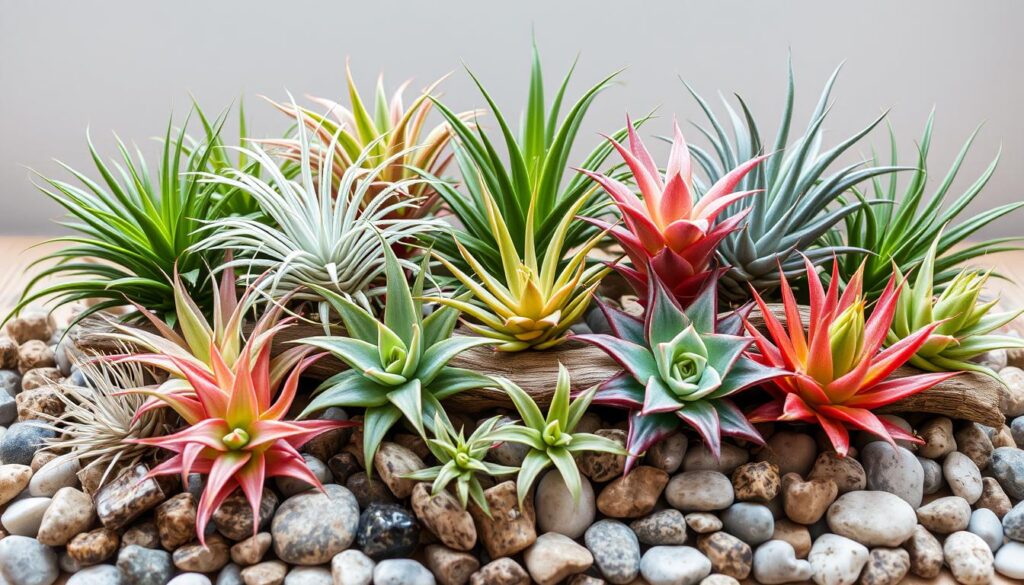
Benefits of Growing Air Plants
Embracing the allure of air plants can bring numerous advantages to your living space. These captivating botanical wonders offer more than just visual appeal; they serve as natural air purifiers and display an unparalleled decorative versatility.
Air Purification
Air plants are renowned for their exceptional ability to cleanse the air around them. With their unique capacity to absorb airborne contaminants and mild chemicals, they can help create a fresher, healthier indoor environment. By incorporating air plants into your home or office, you can enjoy the benefits of improved air quality, especially during drier seasons like winter when indoor air tends to become stagnant.
Decorative Versatility
The beauty of air plants lies in their adaptability. These captivating specimens can be displayed in a myriad of creative ways, from suspended in glass containers and terrariums to mounted on wood or wire frames. Their diverse array of shapes, sizes, and vibrant colors allows for endless possibilities when it comes to curating visually stunning air plant displays. Whether you prefer a minimalist aesthetic or a lush, nature-inspired arrangement, air plants can seamlessly integrate into your decor.
Low Maintenance Requirements
One of the most appealing aspects of air plants care is their low-maintenance nature. Unlike many traditional houseplants, air plants do not require soil or extensive watering routines. Instead, they can thrive with periodic misting or soaking, making them an ideal choice for busy individuals or those new to plant parenting. This user-friendly quality allows you to enjoy the benefits of greenery without the burden of high-maintenance upkeep.
By embracing the versatility and resilience of air plants, you can elevate your living or workspace with a touch of natural beauty while contributing to a healthier, more serene environment. Whether you’re a seasoned plant enthusiast or a novice gardener, air plants offer a rewarding and effortless way to bring the outdoors in.
“Air plants are a fascinating and low-maintenance addition to any space, providing both visual interest and air-purifying benefits.”
Choosing the Right Air Plant
When it comes to growing thriving air plants, also known as Tillandsias, the key is selecting the right variety that suits your environment and preferences. Air plant varieties offer a diverse range of shapes, sizes, and care requirements, so understanding the common types and their unique features is crucial for successful cultivation.
Factors to Consider
Before choosing an air plant, consider the following factors:
- Light requirements: Some air-plant species, like the Tillandsia xerographica, thrive in bright, direct sunlight, while others, such as the Tillandsia ionantha, prefer more indirect or dappled light.
- Size and growth habits: Air-plants can range from compact, rosette-forming varieties to larger, cascading types. Choose a size that fits your display or growing space.
- Leaf texture and color: Air-plant foliage can vary from soft and fuzzy to stiff and rigid, and the leaves may be green, silver, or even reddish in hue.
Common Types and Their Features
Some of the most popular air plant varieties include:
- Tillandsia xerographica: A large, dramatic rosette-forming species with thick, silvery-green leaves that can grow up to 18 inches wide.
- Tillandsia ionantha: A compact, colorful air-plant that produces vibrant, fuchsia-hued bracts and flowers when exposed to bright light.
- Tillandsia tectorum: A soft, fuzzy-leaved variety with a unique, white-woolly appearance that thrives in drier, high-light conditions.
Each air-plant species has its own care requirements, so research is essential to ensure you choose the right variety for your growing environment and personal preferences.
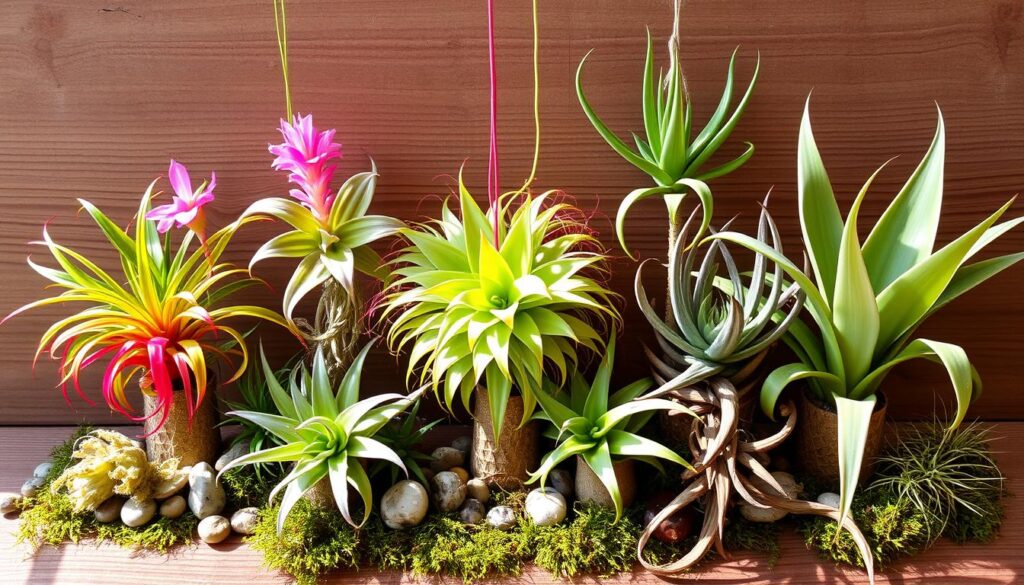
Ideal Growing Conditions for Air Plants
Cultivating thriving air-plants, also known as Tillandsia, requires an understanding of their unique growing needs. These remarkable epiphytes thrive in specific light, temperature, and humidity conditions, as well as unique potting considerations.
Light Requirements
Air-plants prefer bright, indirect light or dappled shade. They excel in areas that receive ample sunlight, such as near a sunny window or under a skylight. However, direct, intense sunlight can scorch their delicate leaves, so it’s essential to find the right balance.
Temperature and Humidity
The ideal temperature range for air-plants is between 50°F and 90°F (10°C to 32°C). They prefer moderate to high humidity levels, typically found in tropical or subtropical environments. In drier climates, regular misting or periodic soaking can help maintain the necessary moisture levels.
Potting Considerations
Unlike traditional houseplants, air-plants do not require soil. They are epiphytic, meaning they naturally grow on other plants or surfaces, absorbing moisture and nutrients from the air. When displaying air-plants, it’s essential to provide adequate air circulation to prevent stagnant conditions that can lead to rot.
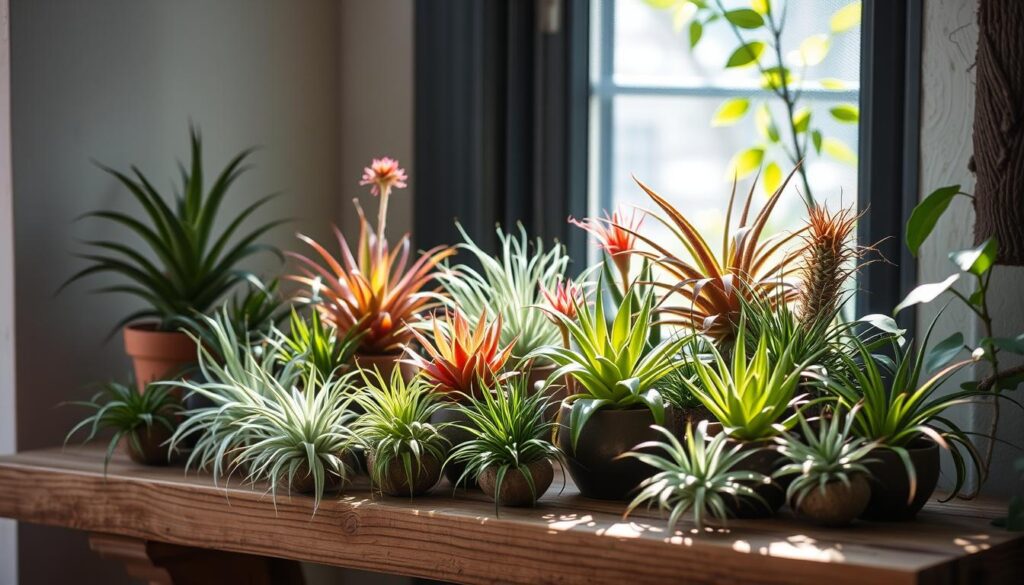
Whether grown indoors or outdoors, air-plants can be mounted on a variety of surfaces, such as driftwood, shells, or wire frames. Avoid enclosed containers that restrict airflow, as this can be detrimental to their health. With the right growing conditions, air-plants can thrive and add a unique and natural touch to any space.
Watering Techniques for Air Plants
Proper watering is crucial for the health and thriving of your air-plants. Two main techniques are recommended – soaking and misting. Soaking your air-plants in non-chlorinated water for 5-10 minutes, once a week, provides them with the moisture they need. Misting, on the other hand, should be done 2-3 times per week to supplement the soaking routine.
Best Methods for Watering
When watering your air-plants, always use non-chlorinated water, such as filtered, distilled, or rainwater. Tap water should be left to sit for a day to allow the chlorine to dissipate before use. Avoid using distilled water as it lacks the essential nutrients air-plants require.
The ideal time to water your air-plants is in the morning, as this allows the leaves to fully dry out before nightfall. Allowing the plants to dry completely is crucial to prevent issues like root rot and fungal growth.
Frequency and Timing
- Soak air-plants in water for 20-60 minutes, once a week to 10 days.
- Mist air-plants 2-3 times per week, especially in dry or warm environments.
- Adjust watering frequency based on the plant’s appearance and environmental conditions.
Signs of Overwatering
Overwatering can be just as detrimental to air-plants as underwatering. Signs of overwatering include browning or softening of the leaves, and rotting of the entire plant due to water accumulation in the base. If you notice these signs, reduce the watering frequency and ensure the plant is drying out properly between waterings.
| Watering Method | Frequency | Best Practices |
|---|---|---|
| Soaking | Weekly to 10 days | Use non-chlorinated water, soak for 20-60 minutes |
| Misting | 2-3 times per week | Mist in the morning, avoid water accumulation |
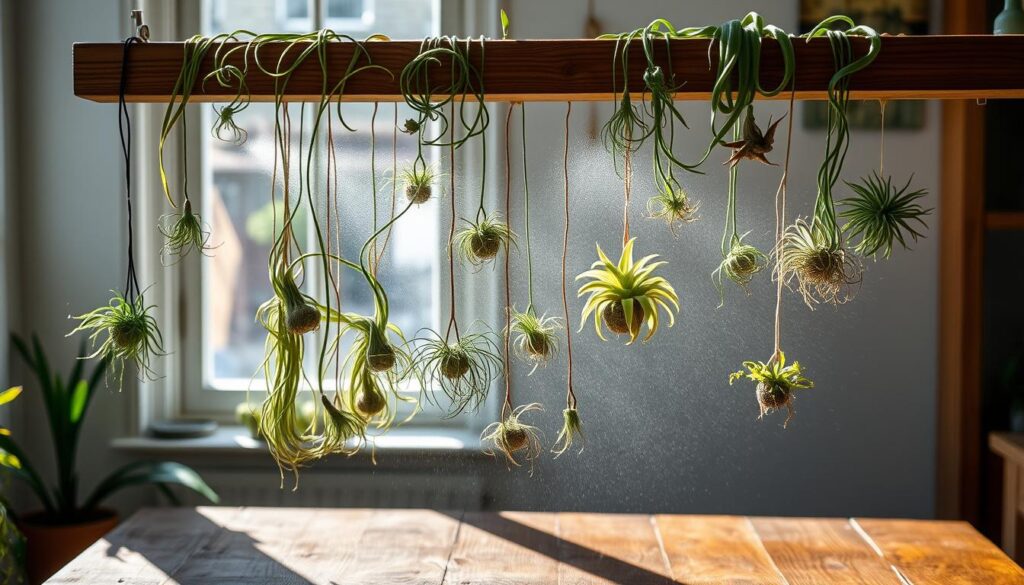
“Tillandsia, the genus of air-plants, are tough and can survive in a variety of growth conditions, but their need for light and proper watering techniques is crucial for their health and longevity.”
Fertilizing Your Air Plants
Proper fertilization is essential for the healthy growth and vibrant appearance of your air-plants. These unique, low-maintenance plants have specific nutrient requirements that should be addressed to ensure they thrive. Let’s explore the best practices for fertilizing your air-plants and how to recognize when they need a nutrient boost.
Types of Fertilizers to Use
When it comes to fertilizing air-plants, you’ll want to choose a fertilizer formulated for epiphytic or orchid plants. These types of fertilizers are designed to meet the specific nutrient needs of air-plants, which are different from traditional potted plants. Alternatively, you can use a diluted general-purpose houseplant fertilizer, but be sure to follow the manufacturer’s instructions carefully.
When and How to Fertilize
- Fertilize your air-plants monthly during the spring and summer growing seasons.
- Apply the fertilizer by misting your plants or adding it to the water during their regular soaking sessions.
- Ensure you use a diluted solution, as air-plants are sensitive to overfertilization.
Signs Your Plant Needs Nutrients
If your air-plants are not thriving, it may be a sign that they are lacking essential nutrients. Look for the following indicators that your plants need a fertilizer boost:
- Slow growth or lack of new growth
- Pale or discolored leaves
- Absence of flowering or blooming
By addressing these nutrient deficiencies through regular, gentle fertilization, you can help your air-plants reach their full potential and maintain their vibrant, healthy appearance.
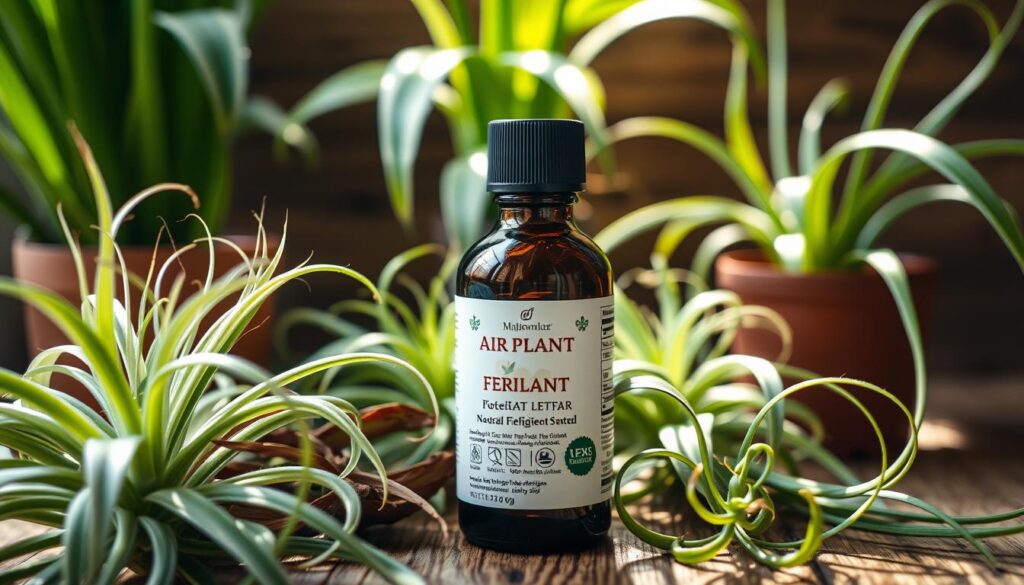
Handling Common Air Plant Issues
Maintaining healthy, thriving air-plants can present unique challenges, but with the right approach, you can easily overcome common problems. From identifying pests and diseases to implementing preventative care tips, this guide will equip you with the knowledge to keep your air-plant collection in top condition.
Identifying Pests and Diseases
Air-plants are generally quite resilient, but they can fall victim to a few common issues. One of the most prevalent problems is root rot, which can occur due to overwatering or poor air circulation. Look for mushy, discolored bases and act quickly to improve drainage and airflow.
Another common pest is the mealybug, a tiny, cotton-like insect that can infest the nooks and crannies of air-plants. Keep an eye out for white, cottony masses and treat with an insecticidal soap or rubbing alcohol solution.
Air-plants may also experience leaf bleaching, which can result from too much direct sunlight. Adjust the lighting conditions and ensure your plants are receiving the appropriate amount of bright, indirect light.
Solutions for Common Problems
When dealing with air-plant issues, the key is to act quickly and address the root cause. For root rot, improve drainage by repotting the plant in a well-ventilated container or mount it on a piece of driftwood or cork. Reduce watering frequency and ensure adequate air circulation.
To combat mealybugs, carefully wipe down the leaves and crevices with a damp cloth or cotton swab dipped in rubbing alcohol. You can also try spraying the plant with an insecticidal soap solution.
If your air-plant is suffering from leaf bleaching, move it to a spot with bright, indirect light and avoid direct sunlight. Misting and increasing humidity can also help revive the plant.
Preventative Care Tips
- Provide proper air circulation by mounting or displaying air-plants in a well-ventilated area.
- Avoid overwatering by following the recommended watering schedule and techniques for your specific air-plant species.
- Monitor for pests and address any issues promptly to prevent the problem from spreading.
- Adjust lighting conditions as needed to ensure your air-plants receive the right amount of bright, indirect sunlight.
By staying vigilant and addressing air plant problems proactively, you can maintain a thriving, healthy collection and enjoy the unique beauty and versatility of these fascinating plants.
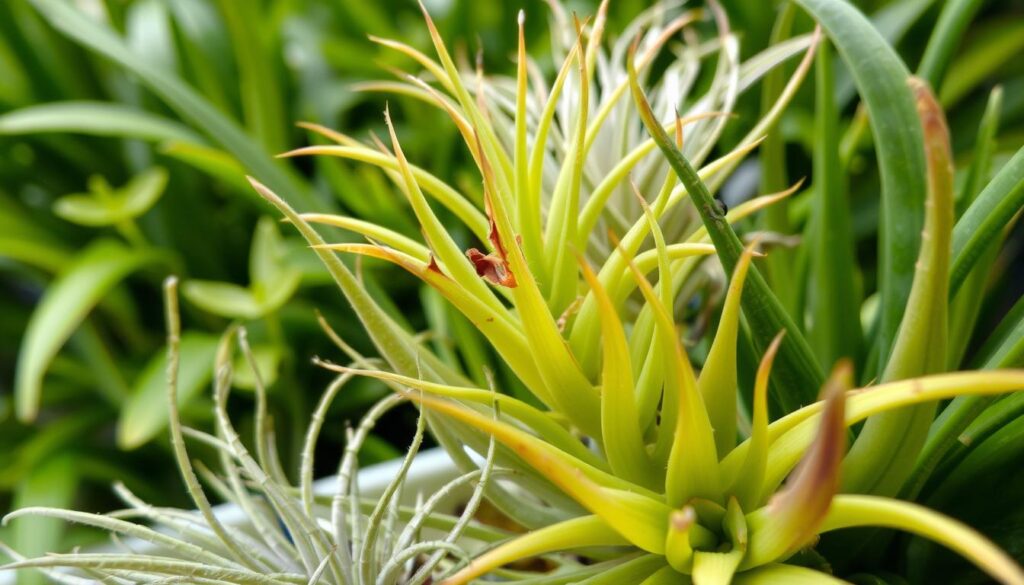
Creative Ways to Display Air Plants
When it comes to showcasing your air-plants, the possibilities are endless. From classic terrariums to modern wall displays, there are countless creative ways to highlight these unique, soil-free beauties. Whether you’re a seasoned air plant enthusiast or just starting your collection, exploring different display options can breathe new life into your indoor garden.
Terrariums and Glass Holders
Encased in glass, air-plants take on an ethereal, almost otherworldly appearance. Terrariums, whether teardrop-shaped, globe-like, or a set of three, provide a captivating way to display your air-plants. These versatile containers come in a variety of sizes, allowing you to curate displays that perfectly suit your space. For a touch of rustic charm, consider showcasing your air-plants in cork bark or Cholla cactus containers.
Wall Mounts and Hanging Displays
Embrace vertical gardening by mounting your air-plants on the wall. Geometric containers, whether metal hanging pendants or ceramic choices, offer a modern and eye-catching way to showcase your Tillandsia. Wired or wooden baskets, macrame hangers, and himmeli structures are also popular options for creating lush, hanging displays. For a more organic aesthetic, try arranging your air-plants in a wooden, metal, or embroidery hoop frame.
Arrangements with Other Plants
Air-plants pair beautifully with a variety of other plant species, allowing you to create visually stunning arrangements. Ceramic hanging pots with multiple compartments make it easy to mix and match different air-plant varieties alongside succulents, ferns, or other complementary foliage. Seashells, sea urchins, and crystal stones can also serve as unique air-plant containers, bringing a touch of natural beauty to your décor.
Regardless of the display method you choose, it’s important to ensure your air-plants receive the proper light, air circulation, and watering access to thrive. With a little creativity and attention to their needs, your air-plants will undoubtedly become the centerpiece of your living space.
Final Thoughts on Air Plant Care
As you’ve learned, successful air-plant care involves providing the right balance of light, water, and air circulation. Start with hardy species like Tillandsia ionantha or Tillandsia usneoides, and gradually expand your collection as you gain experience. With proper care, air-plants can thrive for several years, producing pups for propagation and rewarding you with their unique foliage and beautiful seasonal blooms.
Recap of Care Tips
Remember to water your air-plants regularly, either by soaking them or misting them, and be mindful of signs of over- or under-watering. Provide bright, indirect light and maintain the recommended temperature and humidity levels. Feed your air-plants with a diluted liquid fertilizer during the growing season, and be vigilant for any pests or diseases that may require attention.
Encouragement for New Growers
Don’t be discouraged if your air-plants don’t thrive right away. With patience and a little trial and error, you’ll soon get the hang of caring for these fascinating and low-maintenance plants. Keep experimenting with different watering techniques, light conditions, and display methods to find what works best for your air-plants and your home environment.
Building a Collection Over Time
As you gain confidence in growing air plants, consider expanding your collection to include a variety of species and cultivars. Explore the diverse range of air-plants available, from the silvery-leaved xeric types to the lush, green mesic varieties. Building a diverse air-plant collection can be a rewarding and enjoyable hobby, allowing you to discover new and interesting forms and adaptations.
FAQ
What are air-plants?
Air-plants, also known as Tillandsia, are unique epiphytic plants belonging to the bromeliad family. They grow without soil, absorbing nutrients and moisture through specialized cells called trichomes.
What are the characteristics of air-plants?
Air-plants are epiphytes that grow on other plants or structures without harming them. They use CAM photosynthesis, exchanging gases at night. Air-plants can be categorized as xeric (desert-adapted) or mesic (rainforest-adapted), each with distinct characteristics and care requirements.
What are the benefits of growing air-plants?
Air-plants are excellent air purifiers and offer great decorative versatility. They can be displayed in various ways, including glass containers, terrariums, or mounted on wood or wire frames. Their low maintenance requirements make them ideal for beginners and busy plant enthusiasts.
How do I choose the right air-plant?
When choosing an air-plant, consider factors such as light requirements, size, and growth habits. Common types include Tillandsia xerographica, Tillandsia ionantha, and Tillandsia tectorum, each with unique features and care requirements.
What are the ideal growing conditions for air-plants?
Air-plants thrive in bright, indirect light or dappled shade. They prefer temperatures between 50-90°F (10-32°C) and moderate to high humidity. Proper air circulation is crucial, and they should be avoided from being placed in enclosed containers that limit airflow.
How should I water my air-plants?
Two main watering techniques for air-plants are soaking (5-10 minutes weekly) and misting (2-3 times weekly). Use non-chlorinated water and water in the morning to allow for proper drying. Adjust watering frequency based on the plant’s appearance and environmental conditions.
How do I fertilize my air-plants?
Fertilize air-plants monthly during spring and summer using a fertilizer designed for epiphytic plants or a diluted general-purpose houseplant fertilizer. Apply fertilizer by misting or adding it to the water during soaking. Signs that your plant needs nutrients include slow growth, pale leaves, or lack of flowering.
What are common issues with air-plants and how do I address them?
Common issues for air plants include root rot, mealybugs, and leaf bleaching. Prevent problems by ensuring proper air circulation, avoiding overwatering, and providing appropriate light conditions. Treat pests with insecticidal soap and address rot by improving drainage and air circulation.
How can I creatively display my air-plants?
Display air-plants in glass terrariums, hanging globes, or mounted on driftwood or wire frames. Create wall-mounted displays or mix them with other plants in arrangements. Ensure that the display method allows for proper air circulation and easy watering access.

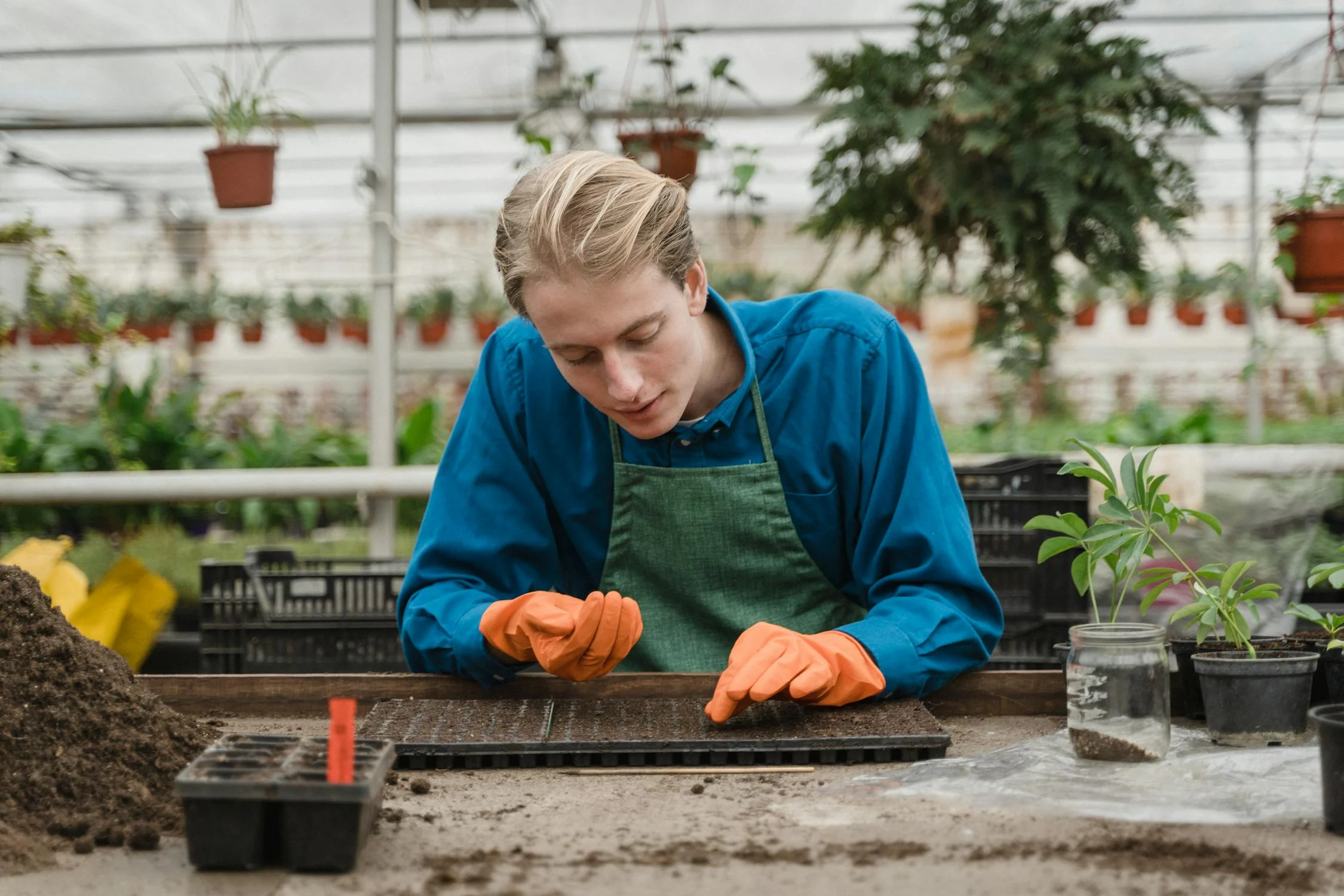
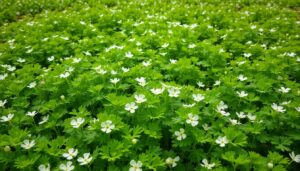
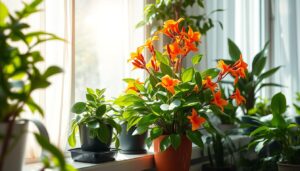

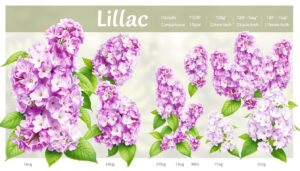

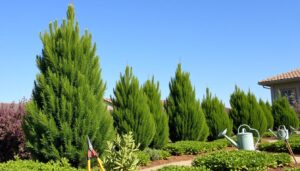
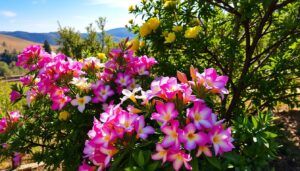
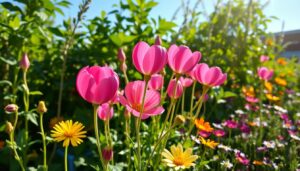
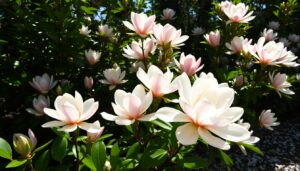
1 thought on “Air Plants: Complete Guide to Growing and Care Tips”